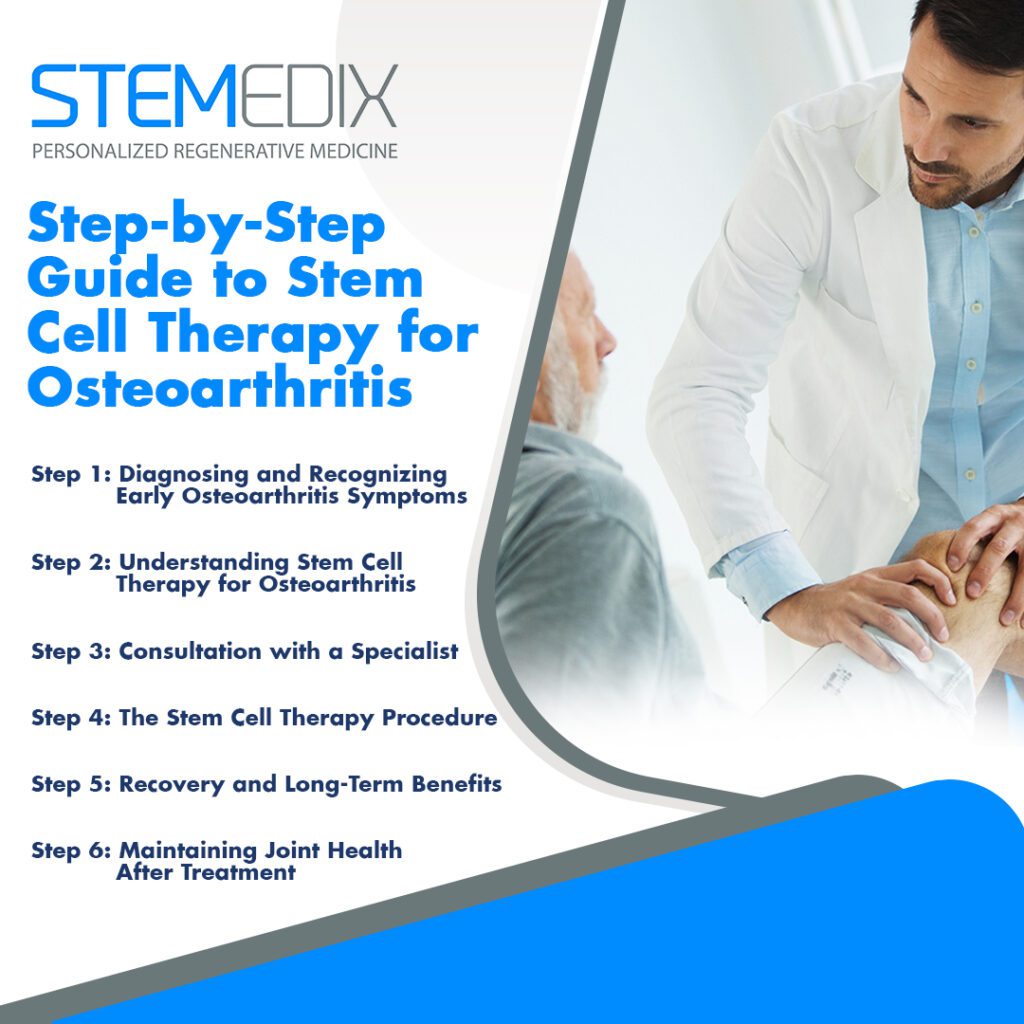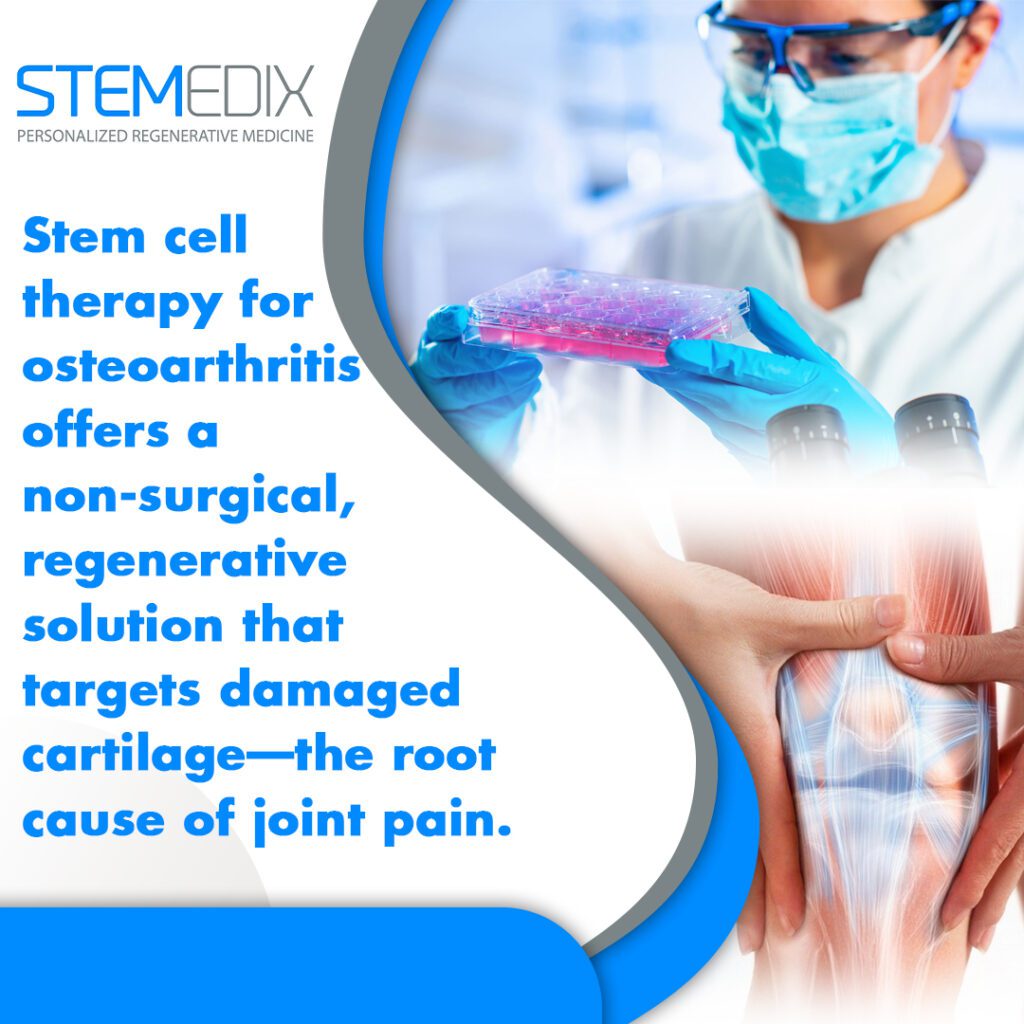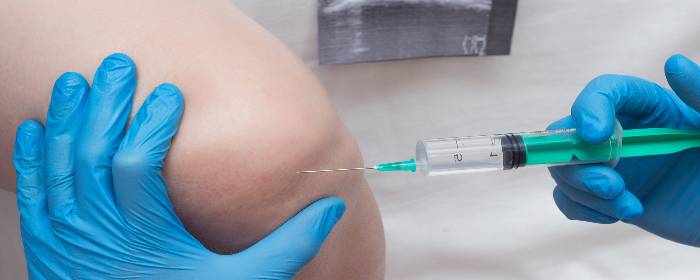
From Diagnosis to Healing: A Step-by-Step Guide to Stem Cell Therapy for Osteoarthritis
Osteoarthritis (OA) is a common and painful joint condition that affects millions of people, causing significant discomfort and limiting mobility. As the cartilage in your joints breaks down over time, you may experience pain, stiffness, and swelling—common signs and symptoms of osteoarthritis. Recognizing early osteoarthritis symptoms can help you seek treatment sooner, potentially slowing the disease’s progression. While traditional treatments like pain medications and joint replacements have been the go-to options for many years, stem cell therapy for osteoarthritis is emerging as a promising alternative.
At Stemedix, we specialize in providing innovative regenerative medicine solutions to help you manage your osteoarthritis symptoms. This blog will guide you through the process of diagnosis, treatment, and recovery with stem cell therapy, showing you how this advanced approach can help heal your joints and improve your quality of life. Let’s explore how stem cell therapy for osteoarthritis could be the solution you’ve been searching for.
Step 1: Diagnosing Osteoarthritis
A successful approach to treating osteoarthritis (OA) begins with a confirmed diagnosis from your orthopedic doctor or primary care provider. If you suspect OA, it’s important to consult with a licensed physician who can assess your symptoms, review your medical history, and determine the severity of the condition.
Diagnosis is typically confirmed through a combination of physical examination and imaging studies, such as X-rays or MRIs. These tests help identify joint degeneration, cartilage loss, and other key signs of OA. Once your diagnosis is established, you can share your medical records and imaging results with the Stemedix team, and we will use this information to customize a regenerative medicine treatment plan tailored to your condition.
Signs and Symptoms of Osteoarthritis
Recognizing the signs and symptoms of osteoarthritis early on can make a significant difference in your treatment options. Common symptoms include joint pain, stiffness, and swelling, especially after activity or prolonged periods of rest. As the disease progresses, these symptoms may worsen, and you might start noticing a limited range of motion in your affected joints. By identifying early osteoarthritis symptoms, you can seek medical attention before the disease advances too far.
At Stemedix, we understand the importance of early detection and timely intervention. Our approach combines a thorough evaluation with advanced regenerative medicine treatments, like stem cell therapy, to help you address osteoarthritis early on and improve your quality of life.
Step 2: Understanding Stem Cell Therapy
Stem cell therapy is becoming an innovative and effective option for managing osteoarthritis, going far beyond temporary symptom relief. This approach utilizes mesenchymal stem cells (MSCs), which are harvested from sources such as adipose (fat) tissue or bone marrow. These powerful cells can differentiate into various cell types, including chondrocytes—specialized cartilage cells responsible for producing and maintaining healthy joint cartilage.
Chondrocytes are gaining attention in the field of regenerative medicine as a critical component in cartilage regeneration. As research continues to evolve, the role of chondrocytes in joint healing is proving to be especially promising for osteoarthritis treatment.
One of the standout benefits of stem cell therapy is its regenerative capacity. Rather than just masking discomfort, this therapy aims to restore damaged cartilage, improve joint function, and offer long-term relief. By stimulating the body’s natural healing response, stem cell therapy may help slow the progression of osteoarthritis and enhance mobility, allowing patients to return to the activities they enjoy.

How Stem Cells Help
Cartilage Regeneration: Stem cells support the repair of damaged cartilage by encouraging the formation of chondrocytes, which help rebuild and maintain the smooth, protective layer over joints.
Pain Relief: MSCs also possess anti-inflammatory properties, which can significantly reduce joint pain and swelling, leading to greater daily comfort.
Increased Mobility: With improved cartilage health and reduced inflammation, many patients experience better joint movement, flexibility, and overall functionality.
Stem cell therapy represents a breakthrough in how osteoarthritis is managed—focusing on healing from within rather than just managing symptoms. At Stemedix, our regenerative approach is designed to help you regain mobility, reduce discomfort, and experience a higher quality of life.
Step 3: Consultation with a Specialist
Before considering stem cell therapy for osteoarthritis, it’s essential to consult with a physician specializing in regenerative medicine. This consultation helps determine if stem cell therapy is the right treatment for your specific condition. Your physician will review your medical history, focusing on your symptoms and previous treatments to understand how OA has progressed and identify factors that may affect treatment options.
During the consultation process, patients are asked to provide existing medical documentation, including imaging results such as X-rays or MRI scans, along with a record of their diagnosis from their primary care provider or specialist. This information allows the Stemedix team to evaluate the extent of joint damage and determine whether stem cell therapy may be a suitable treatment option. Based on this review, a customized regenerative medicine plan is created to support each patient’s specific condition and goals.
What to Expect During the Consultation
Medical History Review: The physician will ask detailed questions about your symptoms, such as when the pain started, how it has progressed, and what treatments have been tried.
Test Results: Imaging results provide a clear picture of joint health. Your doctor will review these images to evaluate the extent of cartilage damage and how advanced the osteoarthritis is. This will help to decide whether stem cell therapy can be a suitable solution or if other treatments might be required.
Treatment Plan: Once the physician has all the necessary information, they will discuss the potential benefits and risks of stem cell therapy. You will learn about the process, from how stem cells are processed and injected into the affected joint to the expected timeline for recovery and improvement. The physician will outline the steps involved in the procedure and answer any questions you may have, ensuring you have a clear understanding of what to expect.
At Stemedix, we believe in making sure you feel fully informed and comfortable with every step of the process. Our team is here to guide you through your journey, helping you make the best decision for your joint health and overall well-being.
Step 4: The Stem Cell Therapy Procedure
Stem cell therapy for osteoarthritis is a minimally invasive procedure that can provide a less disruptive alternative to traditional treatments like surgery. The process involves harvesting stem cells from your own body, typically from bone marrow or adipose tissue (fat), which are then processed and injected directly into the affected joint to stimulate healing.
The procedure is generally well-tolerated and performed under local anesthesia, meaning you’ll remain awake but pain-free during the process. The injection itself is relatively quick, and the recovery time is typically short. Most patients can resume their normal daily activities within just a few days. However, it’s important to avoid high-impact or strenuous activities during the early stages of healing to allow the tissue to regenerate properly.
What Happens During the Procedure?
Stem Cell Harvesting: To begin, a small sample of either bone marrow or fat tissue is collected from your body. This is usually done from the hip or abdomen, areas where these tissues are readily accessible. The process is minimally invasive, requiring only a small incision or needle insertion.
Stem Cell Processing: Once the tissue is harvested, it’s processed in a laboratory setting to isolate the stem cells. The stem cells are then prepared for injection into the damaged joint. This step guarantees that only the necessary cells are used to promote healing.
Injection into the Joint: After processing, the stem cells are carefully injected into the affected joint, where they begin to work on repairing damaged cartilage, reducing inflammation, and promoting overall joint regeneration. This targeted injection allows the stem cells to focus their healing efforts directly where they are needed most.
At Stemedix, we pride ourselves on using advanced techniques and providing clear instructions throughout the procedure. Our medical team makes sure that you are informed and comfortable at every stage of the therapy, helping you feel confident as you take steps toward managing your osteoarthritis more effectively.
Step 5: Recovery and Long-Term Results
After undergoing stem cell therapy for osteoarthritis, the recovery process is vital for ensuring the best results. This stage involves a period of rest and limited activity to give the stem cells time to take effect and begin regenerating the damaged tissue. While the procedure is minimally invasive, your body still needs time to heal and respond to the therapy.
In the weeks following the procedure, you will likely notice gradual improvements. These include reduced pain, enhanced mobility, and better overall joint function. However, it’s important to understand that the full benefits of stem cell therapy can take several months to become fully apparent, as the stem cells work overtime to regenerate cartilage and restore joint health.
Post-Procedure Care
Rest: In the immediate weeks after the procedure, it’s recommended to limit strenuous activities. Resting and avoiding high-impact exercises during this period will allow the stem cells to do their work without disruption.
Follow-Up Appointments: Regular follow-up visits with your physician are essential to track the progress of the therapy and evaluate how well the joint is healing. These appointments will help identify any adjustments needed to optimize your recovery and provide the best possible outcome.
Physical Therapy: Engaging in physical therapy after stem cell therapy is highly beneficial. Physical therapy focuses on improving mobility, strengthening the muscles surrounding the joint, and preventing stiffness. By working with a qualified therapist, you can further enhance the healing process and regain function more effectively.
At Stemedix, based in Saint Petersburg, FL, we take an extensive approach to care, guiding you through each phase of the recovery process. Your dedicated care coordinator will help you stay on track, offering support and resources to maximize the success of your treatment. With patience and proper care, stem cell therapy can provide lasting relief from the symptoms of osteoarthritis, improving your overall quality of life.
Step 6: Maintaining Joint Health
After experiencing the benefits of stem cell therapy for osteoarthritis, it’s essential to adopt a proactive approach to maintaining your joint health. The therapy may help regenerate cartilage and reduce pain, but long-term success depends on how you care for your joint moving forward. Incorporating specific lifestyle changes, ongoing physical therapy, and healthy habits will help support the healing process and prevent further degeneration of the joint.
Tips for Long-Term Joint Health
Low-Impact Exercise: Regular, low-impact exercise is one of the best ways to maintain joint function and mobility. Activities like swimming, walking, or cycling can help keep your joints flexible without putting undue stress on them. These exercises promote circulation and strengthen the muscles surrounding the joint, which helps support it during movement.
Anti-Inflammatory Diet: Nutrition plays a key role in joint health. Consuming foods that are rich in omega-3 fatty acids, antioxidants, and vitamin D can reduce inflammation in the body. This helps keep the joints from becoming inflamed, which can lead to additional damage over time.
Physical Therapy: Continuing with physical therapy can be highly beneficial, even after the stem cell procedure. Regular sessions can enhance the strength and flexibility of the muscles surrounding your joint, which helps reduce the risk of further damage. Additionally, physical therapy can improve your range of motion, making movement easier and more comfortable.
At Stemedix, we encourage patients to take an active role in their joint health after treatment. By following these steps and working closely with your care coordinator and medical professionals, you can maintain the progress made from stem cell therapy and prevent future osteoarthritis complications.

Trust Stemedix for a New Path to Joint Health
Recognizing the signs and symptoms of osteoarthritis early is essential for managing the condition effectively. If you’re experiencing early osteoarthritis symptoms, such as joint pain, stiffness, or swelling, it’s important to seek a professional evaluation as soon as possible. Early diagnosis and intervention can help slow the progression of the disease and improve your quality of life. At Stemedix, we offer advanced stem cell therapy to regenerate damaged cartilage and restore joint function, providing long-term relief from osteoarthritis.If you’re ready to explore how stem cell therapy can help you manage osteoarthritis, contact Stemedix today. Our team of experts is here to guide you through every step of the process and guarantee the best possible outcomes. Call us at (727) 456-8968 or email us at yourjourney@stemedix.com to schedule your consultation and take the main step toward healing.





 St. Petersburg, Florida
St. Petersburg, Florida
